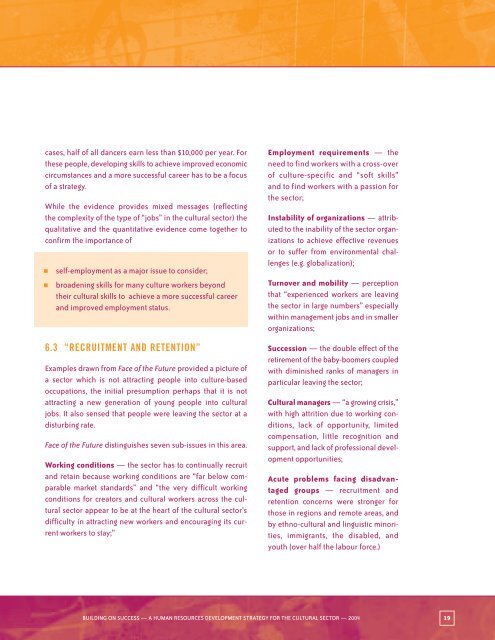Full document
Full document
Full document
You also want an ePaper? Increase the reach of your titles
YUMPU automatically turns print PDFs into web optimized ePapers that Google loves.
cases, half of all dancers earn less than $10,000 per year. For<br />
these people, developing skills to achieve improved economic<br />
circumstances and a more successful career has to be a focus<br />
of a strategy.<br />
While the evidence provides mixed messages (reflecting<br />
the complexity of the type of “jobs” in the cultural sector) the<br />
qualitative and the quantitative evidence come together to<br />
confirm the importance of<br />
• self-employment as a major issue to consider;<br />
• broadening skills for many culture workers beyond<br />
their cultural skills to achieve a more successful career<br />
and improved employment status.<br />
6.3 “RECRUITMENT AND RETENTION”<br />
Examples drawn from Face of the Future provided a picture of<br />
a sector which is not attracting people into culture-based<br />
occupations, the initial presumption perhaps that it is not<br />
attracting a new generation of young people into cultural<br />
jobs. It also sensed that people were leaving the sector at a<br />
disturbing rate.<br />
Face of the Future distinguishes seven sub-issues in this area.<br />
Working conditions — the sector has to continually recruit<br />
and retain because working conditions are “far below comparable<br />
market standards” and “the very difficult working<br />
conditions for creators and cultural workers across the cultural<br />
sector appear to be at the heart of the cultural sector’s<br />
difficulty in attracting new workers and encouraging its current<br />
workers to stay;”<br />
Employment requirements — the<br />
need to find workers with a cross-over<br />
of culture-specific and “soft skills”<br />
and to find workers with a passion for<br />
the sector;<br />
Instability of organizations — attributed<br />
to the inability of the sector organizations<br />
to achieve effective revenues<br />
or to suffer from environmental challenges<br />
(e.g. globalization);<br />
Turnover and mobility — perception<br />
that “experienced workers are leaving<br />
the sector in large numbers” especially<br />
within management jobs and in smaller<br />
organizations;<br />
Succession — the double effect of the<br />
retirement of the baby-boomers coupled<br />
with diminished ranks of managers in<br />
particular leaving the sector;<br />
Cultural managers — “a growing crisis,”<br />
with high attrition due to working conditions,<br />
lack of opportunity, limited<br />
compensation, little recognition and<br />
support, and lack of professional development<br />
opportunities;<br />
Acute problems facing disadvantaged<br />
groups — recruitment and<br />
retention concerns were stronger for<br />
those in regions and remote areas, and<br />
by ethno-cultural and linguistic minorities,<br />
immigrants, the disabled, and<br />
youth (over half the labour force.)<br />
BUILDING ON SUCCESS — A HUMAN RESOURCES DEVELOPMENT STRATEGY FOR THE CULTURAL SECTOR — 2004 19










